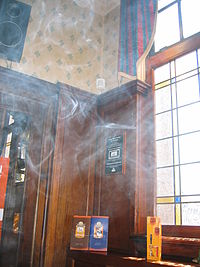
Photo from wikipedia
ABSTRACT This experimental study aimed to evaluate airborne particulates and volatile organic compounds (VOCs) from surgical smoke when a local exhaust ventilation (LEV) system is in place. Surgical smoke was… Click to show full abstract
ABSTRACT This experimental study aimed to evaluate airborne particulates and volatile organic compounds (VOCs) from surgical smoke when a local exhaust ventilation (LEV) system is in place. Surgical smoke was generated from human tissue in an unoccupied operating room using an electrocautery surgical device for 15 min with 3 different test settings: (1) without LEV control; (2) control with a wall irrigation suction unit with an in-line ultra-low penetration air filter; and (3) control with a smoke evacuation system. Flow rate of LEVs was approximately 35 L/min and suction was maintained within 5 cm of electrocautery interaction site. A total of 6 experiments were conducted. Particle number and mass concentrations were measured using direct reading instruments including a condensation particle counter (CPC), a light-scattering laser photometer (DustTrak DRX), a scanning mobility particle sizer (SMPS), an aerodynamic particle sizer (APS), and a viable particle counter. Selected VOCs were collected using evacuated canisters using grab, personal and area sampling techniques. The largest average particle and VOCs concentrations were found in the absence of LEV control followed by LEV controls. Average ratios of LEV controls to without LEV control ranged 0.24–0.33 (CPC), 0.28–0.39 (SMPS), 0.14–0.31 (DustTrak DRX), and 0.26–0.55 (APS). Ethanol and isopropyl alcohol were dominant in the canister samples. Acetaldehyde, acetone, acetonitrile, benzene, hexane, styrene, and toluene were detected but at lower concentrations (<500 μg/m3) and concentrations of the VOCs were much less than the National Institute for Occupational Safety and Health recommended exposure limit values. Utilization of the LEVs for surgical smoke control can significantly reduce but not completely eliminate airborne particles and VOCs.
Journal Title: Journal of Occupational and Environmental Hygiene
Year Published: 2018
Link to full text (if available)
Share on Social Media: Sign Up to like & get
recommendations!